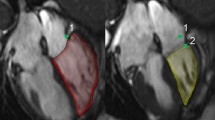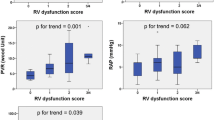Abstract
Purpose
Echocardiography is useful not only for detecting pulmonary hypertension (PH) but also for estimating the severity of PH by evaluating various morphological changes of the heart caused by pressure and volume overload and by ventricular interaction. We investigated whether a novel echocardiographic index, i.e., the ratio of the atrial areas (RA/LA), would be useful for evaluating the clinical status of patients with pulmonary arterial hypertension (PAH) treated with intravenous epoprostenol.
Methods
We introduced epoprostenol therapy for seven PAH patients without severe tricuspid regurgitation. We evaluated clinical criteria indicative of prognosis, for example World Health Organization functional class (WHO-FC), brain natriuretic peptide (BNP) level, echocardiographic indices such as indexed RA area and RA/LA, and hemodynamics before and one year after intravenous epoprostenol therapy.
Results
There were significant improvements in both RA/LA (2.5 ± 1.0, 1.3 ± 0.4, P < 0.001) and indexed RA area (22.5 ± 8.9, 14.5 ± 5.8, P < 0.001). The improvement in RA/LA was more sensitive than that in indexed RA area (P < 0.01). Moreover, RA/LA was significantly correlated with WHO-FC (r = 0.50, P < 0.01) and BNP level (r = 0.82, P < 0.01).
Conclusions
RA/LA is useful for evaluating the clinical status of patients with PAH treated with intravenous epoprostenol.




Similar content being viewed by others
References
Bristow MR, Zisman LS, Lowes BD, et al. The pressure-overloaded right ventricle in pulmonary hypertension. Chest. 1998;114:101S–6S.
Bossone E, Bodini BD, Mazza A, et al. Pulmonary arterial hypertension: the key role of echocardiography. Chest. 2005;127:1836–43.
Hinderliter AL, PWt Willis, Barst RJ, et al. Effects of long-term infusion of prostacyclin (epoprostenol) on echocardiographic measures of right ventricular structure and function in primary pulmonary hypertension. Primary Pulmonary Hypertension Study Group. Circulation. 1997;95:1479–86.
Ryan T, Petrovic O, Dillon JC, et al. An echocardiographic index for separation of right ventricular volume and pressure overload. J Am Coll Cardiol. 1985;5:918–27.
Raymond RJ, Hinderliter AL, Willis PW, et al. Echocardiographic predictors of adverse outcomes in primary pulmonary hypertension. J Am Coll Cardiol. 2002;39:1214–9.
Akagi S, Matsubara H, Ogawa A, et al. Prevention of catheter-related infections using a closed hub system in patients with pulmonary arterial hypertension. Circ J. 2007;71:559–64.
Badesch DB, Abman SH, Ahearn GS, et al. Medical therapy for pulmonary arterial hypertension: ACCP evidence-based clinical practice guidelines. Chest. 2004;126:35S–62S.
Ogawa A, Matsubara H, Fujio H, et al. Risk of alveolar hemorrhage in patients with primary pulmonary hypertension–anticoagulation and epoprostenol therapy. Circ J. 2005;69:216–20.
Leuchte HH, Holzapfel M, Baumgartner RA, et al. Clinical significance of brain natriuretic peptide in primary pulmonary hypertension. J Am Coll Cardiol. 2004;43:764–70.
Nagaya N, Nishikimi T, Uematsu M, et al. Plasma brain natriuretic peptide as a prognostic indicator in patients with primary pulmonary hypertension. Circulation. 2000;102:865–70.
Sitbon O, Humbert M, Nunes H, et al. Long-term intravenous epoprostenol infusion in primary pulmonary hypertension: prognostic factors and survival. J Am Coll Cardiol. 2002;40:780–8.
Eysmann SB, Palevsky HI, Reichek N, et al. Two-dimensional and Doppler-echocardiographic and cardiac catheterization correlates of survival in primary pulmonary hypertension. Circulation. 1989;80:353–60.
Hinderliter AL, Willis PWT, Long W, et al. Frequency and prognostic significance of pericardial effusion in primary pulmonary hypertension. PPH Study Group. Primary pulmonary hypertension. Am J Cardiol. 1999;84:481–4. A10.
Barst RJ, McGoon M, Torbicki A, et al. Diagnosis and differential assessment of pulmonary arterial hypertension. J Am Coll Cardiol. 2004;43:40S–7S.
Bossone E, Duong-Wagner TH, Paciocco G, et al. Echocardiographic features of primary pulmonary hypertension. J Am Soc Echocardiogr. 1999;12:655–62.
Author information
Authors and Affiliations
Corresponding author
About this article
Cite this article
Morishita, T., Miyaji, K., Akao, I. et al. The ratio of the atrial areas reflects the clinical status of patients with pulmonary arterial hypertension. J Med Ultrasonics 36, 201–206 (2009). https://doi.org/10.1007/s10396-009-0228-0
Received:
Accepted:
Published:
Issue Date:
DOI: https://doi.org/10.1007/s10396-009-0228-0




